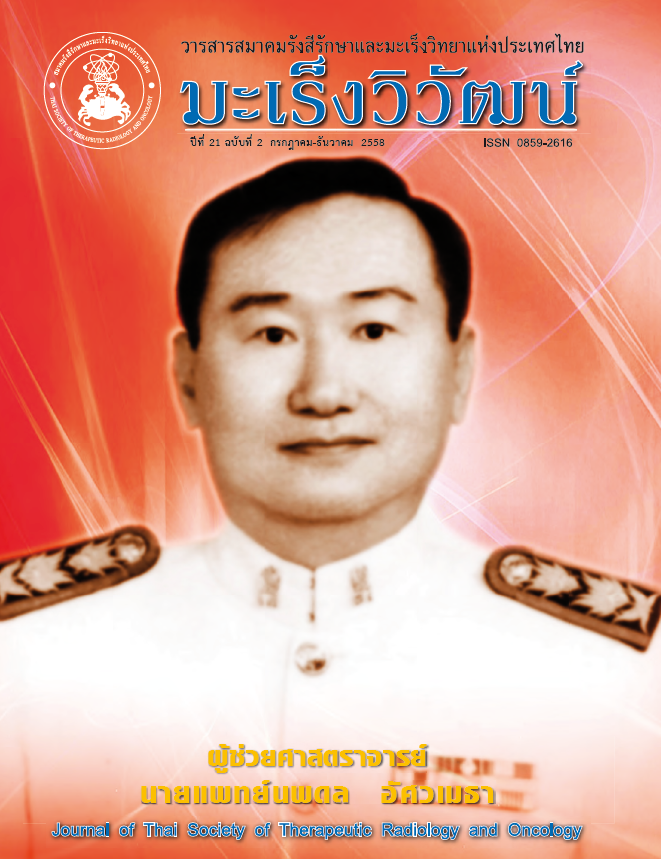Routine blood monitoring during adjuvant radiotherapy for breast cancer patients
Keywords:
Breast cancer, Radiotherapy, Routine blood monitoringAbstract
Routine blood monitoring during adjuvant radiotherapy (RT) are commonly used to monitor for bone marrow suppression from radiation. Researches in the past showed the importance of blood monitoring, but no definite consensus or guidelines about frequency and appropriate times for blood tests. This research retrospectively reviewed charts of breast cancer patients who received radiation after surgery and chemotherapy since 2005 to 2014. The aims of research are to study characters of complete blood counts (CBCs) before and during radiotherapy together with the necessity of weekly CBCs monitoring. Severity of mean blood cells changes are defined by Common Terminology Criteria for Adverse Events (CTCAE) version 4.0. The charts of 222 female breast cancer patients were reviewed. The average age was 51 ± 9.64 years. Majority of patients was stage IIIA (35.14 %). Before radiation, mean counts of all blood cell types ranged between normal and grade 1 adverse event (AE). Between radiotherapy, most of blood cells declined continuously to the lowest levels (nadir phase) in the last week of treatment. Mean counts of all blood cell types in nadir phase ranged between normal and grade 2 AE. All those counts were above critical levels. No patients experienced severe complications or treatment break. In conclusion, even though adjuvant radiotherapy for breast cancer patients after mastectomy and chemotherapy causes bone marrow suppression, mean values of all blood cell types were above critical level and showed no clinical significance. This study revealed that routine weekly CBCs might not be necessary for breast cancer patients who received adjuvant radiation after surgery and chemotherapy completion. CBCs before RT, during 1st and 3rd weeks of RT give adequate information to radiotherapist for awareness of bone marrow suppression and patient care during radiotherapy.
References
Clermont T, Leblanc AK, Adams WH, Leblanc CJ, Bartges JW. Radiotherapy-induced myelosuppression in dogs: 103 cases (2002-2006). Vet Comp Oncol. 2012; 10:24-32.
Romero-Weaver AL, Wan XS, Diffenderfer ES, Lin L, Kennedy AR. Effect of SPE-like Proton or Photon Radiation on the Kinetics of Mouse Peripheral Blood Cells and Radiation Biological Effectiveness Determinations. Astrobiology. 2013; 13:570-7.
Zachariah B, Jacob SS, Gwede C, Cantor A, Patil J, Casey L, et al. Effect of fractionated regional external beam radiotherapy on peripheral blood cell count. Int J Radiat Oncol Biol Phys. 2001; 50: 465–472.
Lundgren MS, Cavalcanti MS, SampaioDA. Weekly monitoring of the effects of conventional external beam radiation therapy on patients with head and neck, chest, and pelvis cancer by means of blood cells count. Radiol Bras. 2008;41:29–33.
Blank KR, Cascardi MA, Kao GD. The Utility of serial complete blood count monitoring in patients receiving radiation therapy for localized prostate cancer. Int J Radiat Oncol Biol Phys. 1999; 44:317–21.
Yang FE, Vaida F, Ignacio L, Houghton A, Nauityal J, Halpern H, et al. Analysis of weekly complete blood counts in patients receiving standard fractionated partial body radiation therapy. Int J Radiat Oncol Biol Phys. 1995; 33:617-17.
Fliedner TM, Graessle D, Paulsen C, Reimers K. Structure and Function of Bone Marrow Hemopoiesis: Mechanisms of Response to Ionizing Radiation Exposure. Cancer Biother Radiopharm. 2002; 17:405-26.
Shao L, Luo Y, Zhou D. Hematopoietic stem cell injury induced by ionizing radiation. Antioxid Redox Signal. 2014; 20:1447-62.
Mary L. Turgeon. Hematopoiesis. In: Peter Sabatini, editor. Clinical Hematology 5th ed. Lippincott Williams & Wilkins, a Wolters Kluwer business; 2012. p. 73-88.
Hayman JA, Callahan JW, Herschtal A, Everitt S, Binns DS, Hicks RJ, et al. Distribution of proliferating bone marrow in adult cancer patients determined using FLT-PET imaging. Int J Radiat Oncol Biol Phys. 2011 Mar 1; 79:847-52.
A Dritschilo, D S Sherman. Radiation and Chemical Injury in the Bone Marrow. Environ Health Perspect. 1981; 39: 59–64
Koukourakis GV, Zabatis H, Zacharias GA, Koukourakis MJ. Post-surgical irradiation causes cellular immune suppression in patients with breast cancer. Eur J Cancer Care. 2009; 18:306-12.
Geinitz H, Zimmermann FB, Stoll P, Thamm R, Kaffenberger W, Ansorg K, et al. Fatigue, serum cytokine levels, and blood cell counts during radiotherapy of patients with breast cancer. Int J Radiat Oncol Biol Phys. 2001; 51: 691-8.
Standish LJ, Torkelson C, Hamill FA, Yim D, Hill-Force A, Fitzpatrick A, et al. Immune defects in breast cancer patients after radiotherapy. J Soc Integr Oncol. 2008; 6:110–21.
Mellios T, Ko HL, Beuth J. Impact of adjuvant chemo- and radiotherapy on the cellular immune system of breast cancer patients. in vivo. 2010; 24: 227-30.
Lalami Y, Paesmans M, Muanza F, Barette M, Plehiers B, Dubreucq L, et al. Can we predict the duration of chemotherapy-induced neutropenia in febrile neutropenic patients, focusing on regimen-specific risk factors? A retrospective analysis. Ann Oncol. 2006; 17: 507–14.
Jenkins P, Scaife J, Freeman S. Validation of a predictive model that identifies patients at high risk of developing febrile neutropaenia following chemotherapy for breast cancer. Ann Oncol. 2012; 23:1766–1771.
U.S. Department of Health and Human Services. National Institutes of Health. National Cancer Institute. Common Terminology Criteria for Adverse Events (CTCAE) Version 4.0 [วันที่สืบค้น 13 ธันวาคม 2557]. เข้าถึงได้จาก http://evs.nci.nih.gov/ftp1/CTCAE/CTCAE_4.03_2010-06-14_QuickReference_5x7.pdf
Mary L. Turgeon. Erythrocyte Maturation, Physiology and Life cycle. In: Peter Sabatini, editor. Clinical Hematology 5th ed. Lippincott Williams & Wilkins, a Wolters Kluwer business; 2012. p. 89-153.
Mary L. Turgeon. Leukocytes: Lymphocytes and Plasma Cells. In: Peter Sabatini, editor. Clinical Hematology 5th ed. Lippincott Williams & Wilkins, a Wolters Kluwer business; 2012. p. 266-280.
Kuender D. Yang and Harry R. Hill. Functional biology of the granulocyte-monocyte series. In: R.L. Bick, J.M. Bennett, R.K. Brynes, M. Cline, L. Kass, G. Murano, S.B. Shohet and P.C.J. Ward, editors. Hematology. Clinical and Laboratory Practice 1st edition. Mosby-Year Book Inc, St Louis; 1993. p. 1077-92.
International Atomic Energy Agency. IAEA-TECDOC-934 Effects of ionizing radiation on blood and blood components: A survey, IAEA, Vienna, 1997. [วันที่สืบค้น 13 ธันวาคม 2557]. เข้าถึงได้จาก URL: http://wwwpub.iaea.org/MTCD/publications/PDF/te_934_prn.pdf
Downloads
Published
How to Cite
Issue
Section
License
บทความที่ได้รับการตีพิมพ์เป็นลิขสิทธิ์ของวารสารมะเร็งวิวัฒน์ ข้อความที่ปรากฏในบทความแต่ละเรื่องในวารสารวิชาการเล่มนี้เป็นความคิดเห็นส่วนตัวของผู้เขียนแต่ละท่านไม่เกี่ยวข้องกับ และบุคคลากรท่านอื่น ๆ ใน สมาคมฯ แต่อย่างใด ความรับผิดชอบองค์ประกอบทั้งหมดของบทความแต่ละเรื่องเป็นของผู้เขียนแต่ละท่าน หากมีความผิดพลาดใดๆ ผู้เขียนแต่ละท่านจะรับผิดชอบบทความของตนเองแต่ผู้เดียว




